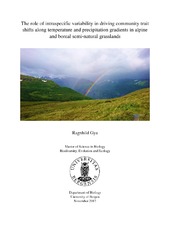The role of intraspecific variability in driving community trait shifts along temperature and precipitation gradients in alpine and boreal semi-natural grasslands
Master thesis
Permanent lenke
https://hdl.handle.net/1956/17229Utgivelsesdato
2017-12-15Metadata
Vis full innførselSamlinger
Sammendrag
Climate projections show that western Norway will experience warmer and wetter conditions in the future. Investigations of trait changes with these climatic gradients can be used to understand the responses of species, communities and ecosystems to climate change. A main assumption within trait-based ecology has been that the variation in traits is larger between species than within species, and hence that mean-species-level trait values can be used in various applications of trait-based ecology. Recent studies find intraspecific trait variability to represent an unneglectable proportion of the total trait variability, and to play an important role in the ecosystems. In this study, I investigated how the trait of alpine and boreal semi-natural grassland plants change with temperature (6.5-10.5 mean temperature in the four warmest months), and precipitation (650-2900 mm/year). All together 2780 leaves from 88 species were collected and used to calculate these functional traits; specific leaf area (SLA), leaf dry matter content (LDMC), leaf thickness, carbon to nitrogen ratio and vegetative height, which are all related to the leaf economic spectrum. Community trait distributions change due to different abiotic and biotic stressors in the interaction between temperature and precipitation. These trends are driven by both intraspecific variability and species turnover effect, and some, but far from all species show patterns in the intraspecific variability that match the community-wide patterns. This study provides evidence that intraspecific trait variability in alpine and boreal semi-natural grasslands is relatively high compared to other habitats, ant that it contributes to shape gradient-wide patterns. The warmer and wetter alpine grasslands of the future are likely to lead to changes in species composition, traits, and ecosystem functioning of these habitats caused by increased abundance of species and genotypes with higher photosynthetic capacity. This change could be caused by shifts in trait distribution by species migrating into these habitats, or species already present, driven by the high proportion of intraspecific variability or by a shift in species abundance. For trait-based ecology these findings imply that the need for including intraspecific variability, by sampling local traits, should be considered for alpine grasslands.
